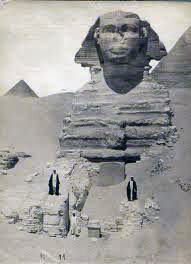|
|


Age Of The Sphinx Controversy
by Linda Leblanc
"When ideas change, everything changes" - John Anthony West
For almost two decades, the Sphinx in Egypt has been the subject of a sometimes rancorous
debate : just how old is it? Egyptologists date the Sphinx to Pharaoh Khafre (Chephren), circa 2,500 BCE. Based on geological weathering due to rainfall, not wind and sand as conventionally accepted, some researchers have challenged this dating.
They claim that the Sphinx is far older than 4,500 years, as there has been no significant rainfall capable of this type of erosion in the Sahara for almost 10,000 years. If this theory is true, it challenges long-held views of the origins of the Sphinx and of the current dating of Egyptian history.
John Anthony West, author, lecturer and guide on Egypt, is the lead researcher who redates the Sphinx to a far older period. West first published this theory in his book, “Serpent in the Sky – The High Wisdom of Ancient Egypt”, in 1979. His research has upset Egyptologists who believe that the Sphinx had been weathered by sand and wind. West points out that the evidence supporting the orthodox view is purely circumstantial, while the water-weathering hypothesis rests on solid geological foundations.
For the past 4,500 years, the Giza area did experience occasional heavy rain and periodic flash floods but, according to some geologists, this was not sufficient to account for the deep degradation in the limestone bedrock of the Sphinx or its enclosure. The current arid climate of the Giza Plateau began about 2350 BCE. It receives only 25-29 mm annual rainfall.
In addition, the Sphinx was buried in sand for over 3,000 of the last 4,500 years, which significantly reduced erosion during this period. The current dating would seem to require that the severe erosion of the Sphinx occurred in an improbably short period of time.
West’s theory that the weathering of the Sphinx was produced by rainfall, not by wind and sand erosion, is based on earlier research by R.A. Schwaller de Lubicz (1891-1962), a French mathematician and scholar who spent two decades studying Egyptian temples during the first half of the 20th century.
With a team of scientists from various disciplines (geology, engineering, climatology, etc.), West set out to investigate Schwaller’s observation that the Sphinx had been eroded by water. One of the team, Dr. Robert Schoch, a tenured Boston University professor, with a Ph.D. in geology and geophysics, believes the Sphinx was built in stages, with initial carving taking place during approximately 7,000 to 5,000 BCE.
An expert in the erosional analysis of rocks, Schoch believes the Sphinx was reworked and refurbished many times, including during the reign of Khafre. He suggests that Khafre merely restored the Sphinx. His research conducted on site at Giza was initially presented in a poster session at the 1991 Annual Convention of the Geological Society of America. It created a media sensation which resulted in a prime time NBC special, “The Mystery of the Sphinx”, which earned an Emmy award.
The theory of erosion by rainfall was subsequently formally presented to the American Geological Society's 2000 annual meeting. As in 1991, hundreds of geologists seemed receptive to the evidence for an older Sphinx. Since then several independent geologists have visited the Giza Plateau to examine the evidence and have published papers supporting the theory of an older Sphinx.
A number of Egyptologists have offered alternative explanations to challenge the weathering of the Sphinx, but West believes his team have adequately countered all the rebuttals put forward to date. One such argument calls for further evidence of an earlier civilization. West says this is rather like telling Magellan the world is flat because there was no evidence that anyone had ever gone round it.
West believes that remnants of an antediluvian civilization may be under the present silt level of the ancient course of the Nile. He thinks there is a chapter missing in our early history and that ancient Egyptians were a later version of an earlier, advanced civilization destroyed during catastrophic upheavals.
This may sound familiar to readers in Cyprus, where we’ve been subjected to much publicity about another controversial theory: that Cyprus was Atlantis. While West does not agree with this Atlantis theory, he wouldn’t be surprised if remnants of an earlier civilization were to be found almost one mile below the current sea level off the coast of Cyprus.
West insists that his aim is to pursue science and scholarship wherever they may lead, even if it means refuting his research. All he asks for is a serious, scientific investigation into his allegations, something that has not yet happened. A few years ago, West established the “Ancient Wisdom Foundation”, a not-for-profit initiative to research further into the reality of a sophisticated civilization existing in remote antiquity.
He is still searching for funding to continue this research and remains convinced that thorough underground surveys will locate deeply buried artifacts of an earlier civilization.
